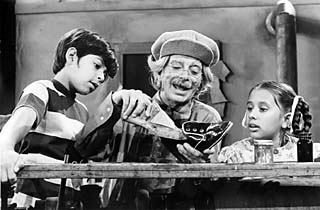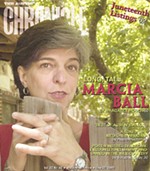Have You Ever Been to Carrascolendas?
Revisiting Austin's award-winning bilingual TV series
By Belinda Acosta, Fri., July 4, 2003

"A decade ago, bilingualism on TV was nonexistent. [Today, it] has clearly found a niche on TV," declared TV Guide critic Sally Bedell in her 1977 article on bilingual children's programming, "A Generation Without Cultural Hang-Ups." If a reading between the lines of Bedell's article is accurate, there's a mild exasperation in her tone when she continues: "sometimes as much as 10 minutes of Spanish appear in some Sesame Street episodes."
Bedell need not have worried. Twenty-five years later, the "niche" she wrote of is now largely nonexistent on broadcast television. With the exception of Sesame Street, all the programs she names are now extinct. However, one show, created at Austin's KLRN (now KLRU), still has fans.
"We still get calls from people who want to see Carrascolendas or get a copy of it," said KLRU senior vice-president of educational services, Linda Schmid. "And KLRU would love to produce another bilingual series if we had the funding."
Demands for educational equity in the 1950s helped lead to the Bilingual Education Act in 1968, which in turn sparked an unprecedented number of bilingual television programs for children, ushering in what turned out to be a golden age of bilingual television. Carrascolendas, which premiered in 1970, has the distinction of being among the first, followed by programs such as Que Pasa, USA?, Villa Alegre, Mundo Real, and La Bonne Aventure (in French and English).
But children weren't interested in teaching concepts or funding sources or the political climate from which Carrascolendas emerged. They were drawn to the fanciful, fast-moving show featuring Agapito the playful bilingual lion and "living" dolls Berta and Dyana who lived in a toy store, Uncle Andy the shoemaker, Campamocha the mechanic, and many others.
The title came from "an oral transposition of Carnestolendas (carnival), the name of one of the earliest ranches on the north side of the Rio Grande River, [which] later became Rio Grande City...," writes the show's creator Aida Barrera in her book, Looking for Carrascolendas: From a Child's World to Award-Winning Television (University of Texas Press, 2001). Fond of the musicality of the word Carrascolendas, Barrera used it for the name of the fictional town where "everyone was special," and lessons were offered in English and Spanish with a decidedly Mexican flair. At first, episodes consisted of unrelated skits and songs heavy on slapstick. Later, episodes featured single storylines with music and dance.
"I still recall the pride I felt in being part of [a show] that aimed ... to develop a positive self concept and [show] that heritage is an important component of the overall richness of the American experience," says Harry Porter, who played Agapito. "Carrascolendas rose up in the midst of a small university and government city. There [wasn't] anything resembling the dynamic artistic, economic, and financial ambience that has since swept Austin in the last 25 years. No recording industry pursued Austin-based musicians, the Zachary Scott [Theatre] was the only theatre, writers were summed up in Walter Prescott Webb and Frank Dobie, and 'dance' summoned visions of the Broken Spoke. This is not to say the show was created in a vacuum. The town was sitting on a lot of talent, people attracted to the lifestyle of the place. Carrascolendas was, to my knowledge, one of the first local platforms that projected Austin's treasures to the nation."
One of those treasures was Aida Barrera. She began her career at KLRN in 1962 while studying Spanish literature at UT. At the time, the PBS station's educational programming consisted of tutorials on core subjects to supplement existing public school curricula. Providing Spanish classes for elementary school children was experimental, and there were no funds to develop such a program. But Barrera didn't know that when she was hired as the new, on-camera Spanish instructor. With great determination, she learned teaching skills, lesson planning, and performance methods on-the-job. The result was her alter ego, Señorita Barrera. Little did she know how well her appealing, onscreen persona would serve her when she approached KLRN station management with her idea to expand the program into a more dynamic bilingual children's program.

"If Carrascolendas had a fairy godmother, I would have to say it was Margaret Caldwell Scarbrough," Barrera writes. As it turns out, Scarbrough (of the local department store chain) was a faithful viewer. She wrote to then KLRN station manager Harvey Herbst, saying Señorita Barrera "was one of the greatest things on Austin television." With her praise came a donation of $1,000. Scarbrough's unsolicited support seeded Barrera's first trips to Washington and New York, where she sought support for Carrascolendas.
After negotiating the dazzling maze of federal education agencies, submitting proposals, and hearing nothing, Barrera gave up hope. Then, several months later, a phone call from the then Office of Education summoned Barrera to a regional meeting. Carrascolendas was awarded $200,000 to produce 30 half-hour, black-and-white programs.
In 1974, the program began airing nationally, in color, with an operating budget of $1.5 million. The increased support allowed for location shoots across the U.S., expansion of the cast to include Cuban and Puerto Rican Latinos, and more writers, designers, and puppets. At the height of its run, two crews worked with two directors, 14 hours a day, seven days a week, to produce one new program every three days, according to an Austin American-Statesman article by Marjorie Hoffman (July 28, 1974). The show's set filled a 5,400-foot studio, allowing cameras a 360-degree sweep. The centerpiece was a mill with an operational, 15-foot paddle wheel that churned real water. New episodes aired on Saturday mornings, with reruns throughout the week.
Teaching While Amusing
"Have you ever been to Carrascolendas,
Carrascolendas, Carrascolendas?
If you've never been to Carrascolendas,
Come along, come along,
Come along, come along,
To Carrascolendas."

-- lyrics to Carrascolendas theme song
Born in Dallas and trained at the Dallas Theater Center, Mike Gómez joined the Carrascolendas cast in 1972 playing Campamocha the mechanic. He was 19 years old, and Carrascolendas was his first paying acting job.
"It was a wonderful training ground that has served me well over the years as a professional actor," Gómez said from his Los Angeles home. "Even though [Carrascolendas] sounds like a simple show, it was very well-produced. And because it was educational, we had to be word-perfect in English and in Spanish. It forced me to be disciplined. I learned about the business of television work -- working with script changes, working under pressure."
Like Gómez, Porter had trained at the Dallas Theater Center. He was living in Veracruz, Mexico, but made his way to Austin when he learned of auditions for the new TV show. "I loved it," he says. "I had fun. I grew, and I think our young audience did, too."
Children were not limited to the audience, however. A core group of 25-27 children appeared on Carrascolendas throughout the year. Cast from annual auditions, child cast members prepared by taking Saturday workshops in Spanish, voice, and movement.
"I remember the Saturday activities, but I don't remember them as work," says Cara Briggs, who appeared on the show from age 6 to 9. "I spent a good part of my childhood in that old communications building (on Speedway). It was fun, but I took it very seriously."
Natalie Dowd was a student in the UT Department of Theatre and Dance who was in the cast and helped select and train children for performance. With the tight production schedule, there was no time for play. Yet, there was a strong sense of family.
Briggs says, "I remember when the actor who played Tío Cheo (Armando Roblán) returned from visiting his family in Cuba, the cast got together to meet him at the airport. He left one family and came back to another."
Last Days
In 1976, after 220 episodes, several major awards, including the UNICEF prize, and an Emmy Award nomination for outstanding community service, Carrascolendas ended production. The basic reason is that it lost its federal funding, but the larger cause had to do with the change in temperament around bilingual education since the enactment of the Bilingual Education Act, the goals of which were not well defined to begin with: Was it supposed to mainstream Spanish speakers into English or provide a means for all students to acquire a second language while supporting their native language, whatever it might be? Charges of special treatment for Hispanics came from one side, while the characterization of bilingual programs as a new form of educational segregation came from another. Throughout the 1970s, reports of ill-used or squandered funds made the public even more suspicious of bilingual education's value, and federal funds diminished.
"Carrascolendas was much too parochial to survive. It was mainly geared to Hispanics in the Southwest," said a critic in Bedell's TV Guide article. Perhaps charges of regional and cultural chauvinism are ill-advised, but one has to wonder why the cultural specificity of a program would be less appealing to audiences, in favor of the nondescript "Mexican" milieu of Villa Alegre, a bilingual show that continued in Carrascolendas' wake. In spite of this and other curious critiques, the fact was that countless viewers around the country enjoyed Carrascolendas during its heyday and in reruns that aired many years after production ended.
As for the bilingual television niche that came and went, current trends suggest it's rising again -- rapidly. According to a recent Associated Press article by John Rogers, the Nickelodeon series Dora the Explorer, featuring the adorable bilingual tot, has "vaulted past Blue's Clues as the most popular show on cable or commercial television among preschoolers." Not only has the animated series done this in less than two years, it's also attracted 6- to 11-year-olds considered "too self-consciously cool" to watch the show.
Noncable subscribers need not fret if they've yet to see the adorable Dora; a road show starring the heroine begins next year. On broadcast TV, PBS will premiere a new bilingual series, The Misadventures of Maya and Miguel, in September 2004. Experts predict that economic market forces influenced by "browning" demographics will beget even more bilingual programming on TV.
As always, in any language, money talks. ![]()








